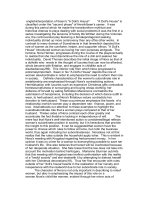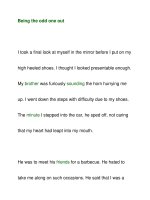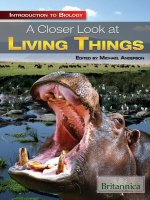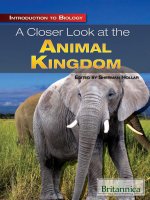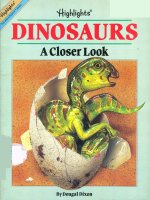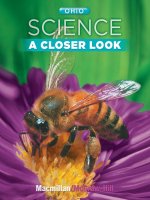elementary a animals look
Bạn đang xem bản rút gọn của tài liệu. Xem và tải ngay bản đầy đủ của tài liệu tại đây (1.21 MB, 31 trang )
1
2
3
4
5
6
7
8
9
10
11
12
13
14
15
16
17
18
19
20
21
22
23
24
25
26
27
28
29
30
31
32
33
34
35
To the reader:
Welcome to the DK ELT Graded Readers! These readers are
different. They explore aspects of the world around us: its history,
geography, science … and a lot of other things. They show the
different ways in which people live now, and lived in the past.
These DK ELT Graded Readers give you material for reading
for information, and reading for pleasure. You are using your
English to do something real. The illustrations will help you
understand the text, and also help bring the Reader to life.
There is a glossary to help you understand the special words for
this topic. Listen to the cassette or CD as well, and you can
really enter the world of the Olympic Games, the Titanic, or
the Trojan War … and a lot more. Choose the topics that
interest you, improve your English, and learn something …
all at the same time.
Enjoy the series!
To the teacher:
This series provides varied reading practice at five levels of
language difficulty, from elementary to FCE level:
BEGINNER
ELEMENTARY A
ELEMENTARY B
INTERMEDIATE
UPPER INTERMEDIATE
The language syllabus has been designed to suit the factual
nature of the series, and includes a wider vocabulary range
than is usual with ELT readers: language
linked with the specific theme of each
book is included and glossed. The
language scheme, and ideas for
exploiting the material (including the
recorded material) both in and out of
class are contained in the Teacher’s
Resource Book.
We hope you and your students enjoy
using this series.
y
Size: 228mm x 150mm(175# Elliptical)
Folio: (P04-05)
K C
K C
There are many different kinds of animal eyes
and ears. This is an obvious fact and we can see
some of the differences on these pages. For example,
let’s think about the position of the eyes. The cat
and the fox have eyes at the front of their faces.
4
Paperback level 2 228 x 150mm UK
y
Size: 228mm x 150mm(175# Elliptical)
Folio: (P04-05)
While every effort has been taken to carry out instruction to customers satisfaction
NO RESPONSIBILITY liability will be accepted for errors.
CUSTOMERS ARE THEREFORE URGED TO CHECK THOROUGHLY BEFORE
AUTHORISING PRINT RUNS.
M Y
M Y
Page
04/5
16/07/99 H1M15
H43887
LM2M13
K57
CT
K
QC
212/203
1
The cat and fox have quite large ears, facing forwards. They
are triangular, and they can move around. But where are the
eagle’s and caiman’s ears? In fact, do they
have any ears at all?
The answer is yes.
They have ears, but you
can’t see them. Why are
these animals’ ears so
different? The answer is
connected with evolution.
Through many thousands of
years, each animal slowly changed.
The caiman’s eyes are high on top of its head.
What is the reason for these different positions?
What about ears? Let’s think about shape,
as well as position. How are
they different in these
four animals?
Paperback level 2 228 x 150mm UK
5
Title: E/W Reader – Eyes & Ears
Size: 228mm x 150mm(175# Elliptical)
Folio: (P6/7)
K C
K C
Paperback level 2 228 x 150mm UK
6
Our investigations begin with three predators (hunters) and
one herbivore (plant-eater). Can you guess the names of
these animals? The three hunters are active in dark places.
In other words, where there is very little light.
This is a close-up of an owl’s eye. It is very big because
owls are active at night. Even in the poorest light their eyes
are very sensitive. Human eyes need much stronger light
than owls’ eyes. And even then, we can only just see
things in the dark.
Title: E/W Reader – Eyes & Ears
Size: 228mm x 150mm(175# Elliptical)
Folio: (6/7)
While every effort has been taken to carry out instruction to customers satisfaction
NO RESPONSIBILITY liability will be accepted for errors.
CUSTOMERS ARE THEREFORE URGED TO CHECK THOROUGHLY BEFORE
M Y
M Y
Page
6/7
14/09/99 H1M00
H46219
Disk
M1101
K56
CT
0
K
QC
207/209
OP
SCAN
4
Paperback level 2 228 x 150mm UK
The squid lives in the sea. It has
two large eyes, one on each side of
its head. Like the owl, it needs large
eyes because it hunts in the dark. It
is an amazing fact that in structure
the squid’s eyes are almost the same
as human eyes.
Here is the eye of a cat, another
hunter. Cats usually hunt at night but
sometimes they are active during the
day, too. Their eyes work well in
bright light or in very little light.
Inside the eye, there is an extra layer
of cells. They form a kind of mirror
that reflects light and improves the
image. Shine a flashlight at a cat, and
its eyes glow like strange lights. (See
“Eyes with mirrors” on page 9.)
Which animal does this eye belong
to? It’s a giraffe’s eye. This animal is
active during the day. It has excellent
eyesight. It can see a hungry lion or
tiger from a great distance. And
because it can run as fast as 56
kilometres an hour, it can usually
escape its predators.
7
6L]HPP[PP(OOLSWLFDO
)ROLR3
. &
. &
As you can see, the owl’s eyes are at
the front of its head. This frontal
position increases the angle of
binocular vision. Both eyes together
see the same object. With good
binocular vision, the owl can judge
distance accurately. It watches
from a high place and keeps its
prey in view.
There is something else
about the owl’s eyes: it cannot
rotate them. Human eyes can
move from side to side and up
and down. But an owl cannot do
this. In fact, the fixed eyes are
useful because they can detect
movement very well. And the
owl’s head can turn easily. An owl
can see a moving mouse from a
great distance.
The squid has ten tentacles (arms),
not eight like an octopus. And squids are much
more active than octopuses. There
are many different kinds of squid,
ranging from a few centimetres to
around 18 metres.
8
Paperback level 2 228 x 150mm UK
9
6L]HPP[PP(OOLSWLFDO
)ROLR3
:KLOHHYHU\HIIRUWKDVEHHQWDNHQWRFDUU\RXWLQVWUXFWLRQWRFXVWRPHUVVDWLVIDFWLRQ
125(63216,%,/,7< OLDELOLW\ZLOOEHDFFHSWHGIRUHUURUV
&86720(56$5(7+(5()25(85*('72&+(&.7+2528*+/< %()25(
$87+25,6,1*35,17 5816
0 <
0 <
+0
1/
.
&7
.
4&
The giraffe uses its eyes as a
defence mechanism. They help it
to see a great distance. It can see its
enemies, and so it can run away.
And why are the eyes at the
sides of its head? Because it
must look out for danger
coming from any direction.
The cat’s eyes are at the front of the face, like
the owl’s eyes. And the cat also hunts at
night. It can see in the dark about six times
better than human beings.
Eyes with mirrors
Cats have a special mechanism at the back
of their eyes. This acts like a mirror, and
reflects light. This is very useful at night.
Paperback level 2 228 x 150mm UK
7LWOH(: 5HDGHU²(\HV(DUV
6L]HPP[PP(OOLSWLFDO
)ROLR3
. &
. &
Spiders have four pairs of legs. Most spiders have eight eyes,
like this jumping spider. The two biggest eyes are at the
front, and the other eyes are all around the head. Other
kinds of spiders may have six, four, or two eyes. Spiders that
live in caves and dark places may not have any eyes at all.
These soft-bodied creatures do not
have ears, but they have many
special vibration receptors (hairs) on
their bodies. These receptors can
“hear” sounds from other spiders or
sounds from their prey. They catch
and eat mainly insects.
Spiders can communicate with
each other. They make drumming
noises with parts of their bodies. They can also communicate
with special chemicals or pheromones. Male spiders can find
females by following the scent in the silk web. But male
spiders have a problem.
Very often a female wants to eat a male. He must send
the right kind of vibrations through her web. Then the
female knows that it is her mate on the web and not the
next meal. But even careful males sometimes end up as food
for the hungry female.
Four eyes
This little fish has very good visual
equipment. It can spend a lot of time on
the surface of the water, because it has
unusual eyes. In fact, it has two eyes for
looking up, and two for looking down.
10
Paperback level 2 228 x 150mm UK
7LWOH(: 5HDGHU²(\HV(DUV
6L]HPP[PP(OOLSWLFDO
)ROLR
:KLOHHYHU\HIIRUWKDVEHHQWDNHQWRFDUU\RXWLQVWUXFWLRQWRFXVWRPHUVVDWLVIDFWLRQ
125(63216,%,/,7< OLDELOLW\ZLOOEHDFFHSWHGIRUHUURUV
&86720(56$5(7+(5()25(85*('72&+(&.7+2528*+/< %()25(
$87+25,6,1*35,17 5816
0 <
0 <
3DJH
+0
+
'LVN
/1
.
&7
.
4&
23
6&$1
The horsefly is an insect. Unlike a spider,
the horsefly has three pairs of legs, and it has
three parts to its body. It has two very big eyes
on top of its head. We call these eyes compound eyes. Each
compound eye has hundreds of tiny, individual lenses. And
each tiny “eye” can see a bit of the whole picture. Some
insects, particularly the hunters, can have as many as 30,000
“eyes”. With so many tiny parts in their eyes, insects like
this fly can see in almost every direction. This is why it is
very difficult to catch a fly. It can always see you first!
Insects and human beings probably don’t see colours in
the same way. Insects can see ultra-violet light. This ability
helps them to find nectar (food) in plants. They can see the
ultra-violet guidelines that lead to the flower’s nectar.
11
Paperback level 2 228 x 150mm UK
7LWOH(: 5HDGHU²(\HV(DUV
6L]HPP[PP(OOLSWLFDO
)ROLR3
. &
. &
Paperback level 2 228 x 150mm UK
Vultures are a common sight in many
parts of the world, such as Asia and
Africa. They are birds of prey and
must hunt for their food.
The vultures of Africa depend on
thermals for successful hunting. A
thermal is a rising column of hot air. Every
morning, vultures sit in thorn trees and wait for the sun
to rise and heat the land. Then a thermal begins to form. It
catches beneath the vultures’ wings and lifts the birds into
the sky. Round and round they go, rising up the column of
hot air. On top of the thermal, the vultures are hundreds of
metres above the savannah. Here they can look down and,
with their excellent eyesight, they can see a very long way.
They look for dead or sick animals.
You can see that this vulture has very few feathers on its
head and neck. This is necessary because vultures eat dead
animals. They must keep their necks and heads as clean as
possible at feeding time.
12
7LWOH(: 5HDGHU²(\HV(DUV
6L]HPP[PP(OOLSWLFDO
)ROLR3
:KLOHHYHU\HIIRUWKDVEHHQWDNHQWRFDUU\RXWLQVWUXFWLRQWRFXVWRPHUVVDWLVIDFWLRQ
125(63216,%,/,7< OLDELOLW\ZLOOEHDFFHSWHGIRUHUURUV
&86720(56$5(7+(5()25(85*('72&+(&.7+2528*+/< %()25(
$87+25,6,1*35,17 5816
0 <
0 <
3DJH
+0
+
'LVN
0
.
&7
.
4&
23
6&$1
Paperback level 2 228 x 150mm UK
Tarsiers are very small animals. Even the largest kind
of tarsier is only 15 centimetres long. They like to sit
in trees and can hold on with special discs on their
fingers and toes. They are carnivores and eat insects,
frogs, lizards and small birds. But because they are
night hunters, they need enormous eyes. They can
see their prey in poor light, but they can also see
any dangers. They can turn their heads in a
complete circle. This is a very useful ability for
such a small animal. It can easily see a predator
that is looking for a tasty meal.
13
7LWOH(:5HDGHU²(\HV(DUV
6L]HPP[PP(OOLSWLFDO
)ROLR3
. &
. &
14
Moles spend nearly all their lives
underground. They are only
small, but they are very strong.
They have very powerful
front legs with five fingers
on each hand. These can
dig long tunnels in the
ground. Most of the tunnels
are like underground highways. But some of the tunnels are
feeding stations. Here moles stop to eat worms or small
insects. Or, sometimes, they use their feeding stations as
larders for storing food.
When moles make tunnels, they make molehills at the
same time, like the one below. Molehills are often a big
problem for people with gardens. One mole can make as
many as a hundred molehills.
Because moles live underground, they have very poor
eyesight. Luckily, they have a highly developed sense of
smell and touch. Their sensitive noses can smell and feel
worms and insects in the ground. Moles are very hungry
little animals. In one day they can eat at least half their
body weight in food.
Paperback level 2 228 x 150mm UK
1
2
3
4
5
6
7
8
9
10
11
12
13
14
15
16
7LWOH(: 5HDGHU²(\HV(DUV
6L]HPP[PP(OOLSWLFDO
)ROLR3
:KLOHHYHU\HIIRUWKDVEHHQWDNHQWRFDUU\RXWLQVWUXFWLRQWRFXVWRPHUVVDWLVIDFWLRQ
125(63216,%,/,7< OLDELOLW\ZLOOEHDFFHSWHGIRUHUURUV
&86720(56$5(7+(5()25(85*('72&+(&.7+2528*+/< %()25(
$87+25,6,1*35,17 5816
0 <
0 <
3DJH
+0
+
'LVN
/Q
.
&7
.
4&
23
6&$1
15
Earthworms are the favourite food of moles. These animals
also live underground. But they have no eyes at all. In fact,
earthworms do not have any specialised sense organs. But
their skin is sensitive to light, and they can
detect movement nearby.
Food stores for later
Moles catch a lot of worms. They bite
off their heads and store them. A
scientist once found a mole’s store with
more than 1,000 earthworms inside, in
neat piles. The worms in the store do
not die. But without their heads, they
cannot escape. So the food is fresh.
They have short bristles (hairs) under their bodies.
With the help of these hairs, the worms can move
more easily through the ground.
Earthworms are important animals for agriculture.
Huge numbers of worms live under the ground. They
improve the soil in several ways. They pull dead leaves into
the ground, and they also eat soil. The soil passes through
their bodies and comes out in the form of wormcasts. This
activity brings mineral-rich soil nearer the surface and is
very good for growing plants.
Paperback level 2 228 x 150mm UK
7LWOH(: 5HDGHU²(\HV(DUV
6L]HPP[PP(OOLSWLFDO
)ROLR3
. &
. &
This snail is a herbivore, like most other land snails. It
usually eats dead leaves. It has got hundreds of tiny teeth on
its radula (tongue). Because the snail is always eating and
chewing, the radula continually grows new teeth.
The snail’s eyes are on the ends of two tentacles. Because
it can move its tentacles around, it can get a good view of
everything on the ground. It can also pull the tentacles into
its head to protect its eyes. It can even pull its whole body
into the hard shell. This is how the snail protects its soft
body from danger, or from very cold or hot weather.
16
Snails do not have ears. They are silent animals. They can’t
hear, or communicate with sound. But they leave behind a
silver trail. This is a slimy substance from the snail’s “foot”
under its body. It helps the snail to move smoothly and
silently along the ground.
Paperback level 2 228 x 150mm UK
7LWOH(: 5HDGHU²(\HV(DUV
6L]HPP[PP(OOLSWLFDO
)ROLR3
:KLOHHYHU\HIIRUWKDVEHHQWDNHQWRFDUU\RXWLQVWUXFWLRQWRFXVWRPHUVVDWLVIDFWLRQ
125(63216,%,/,7< OLDELOLW\ZLOOEHDFFHSWHGIRUHUURUV
&86720(56$5(7+(5()25(85*('72&+(&.7+2528*+/< %()25(
$87+25,6,1*35,17 5816
0 <
0 <
3DJH
+0
+
'LVN
1/
.
&7
.
4&
23
6&$1
17
A camel also has a special mechanism that protects its
eyes. In the desert it is often windy, with a lot of sand
in the air. So camels have two rows of eyelashes. These
protect the eyes from sand and from the bright sun.
The ears also contain hairs to keep the sand out.
An extra eyelid
Birds of prey, like this eagle, have an
extra eyelid. This is a clear film of skin
that protects the eye. Birds of prey fly
great distances and at great heights. And
they often fly in very dusty air. The extra
eyelids keep their eyes clean and healthy.
Paperback level 2 228 x 150mm UK
7LWOH(: 5HDGHU²(\HV(DUV
6L]HPP[PP(OOLSWLFDO
)ROLR3
. &
. &
Here is a pair of meerkats – male and
female. They are watching out for danger.
They belong to a community of meerkats
that lives in southern Africa.
Cats are also very watchful animals. They must
keep their ears and eyes clean at all times.
18
A cat’s ears can move in the direction
of a sound. And they have large ears
to collect as much sound as possible.
Paperback level 2 228 x 150mm UK
7LWOH(: 5HDGHU²(\HV(DUV
6L]HPP[PP(OOLSWLFDO
)ROLR3
:KLOHHYHU\HIIRUWKDVEHHQWDNHQWRFDUU\RXWLQVWUXFWLRQWRFXVWRPHUVVDWLVIDFWLRQ
125(63216,%,/,7< OLDELOLW\ZLOOEHDFFHSWHGIRUHUURUV
&86720(56$5(7+(5()25(85*('72&+(&.7+2528*+/< %()25(
$87+25,6,1*35,17 5816
0 <
0 <
3DJH
+0
+
'LVN
/0Q
.
&7
.
4&
23
6&$1
Elephants are the largest
land animals in the world.
Almost everything about
an elephant is large,
especially its head and
ears. But an elephant’s
eyes are quite small in
comparison with the rest
of its body.
Bats have even larger ears. This is
because bats have very poor eyesight. They
hunt at night, and in the daytime they live in
dark places, like caves. Their survival depends
on their sense of hearing. You will read more
about this later.
19
Paperback level 2 228 x 150mm UK
7LWOH(: 5HDGHU²(\HV(DUV
6L]HPP[PP(OOLSWLFDO
)ROLR3
. &
. &
Do you recognise the ears on these pages? Which animals do
they belong to? Here are some clues.
This is a very small animal. It has brown hair, a long tail,
and tiny feet. It has large eyes and ears. It eats vegetarian
food like seeds. This animal looks for food at night. But it
must watch out, because it is the favourite food of many
night hunters, like cats and owls.
20
Paperback level 2 228 x 150mm UK
7LWOH(: 5HDGHU²(\HV(DUV
6L]HPP[PP(OOLSWLFDO
)ROLR
:KLOHHYHU\HIIRUWKDVEHHQWDNHQWRFDUU\RXWLQVWUXFWLRQWRFXVWRPHUVVDWLVIDFWLRQ
125(63216,%,/,7< OLDELOLW\ZLOOEHDFFHSWHGIRUHUURUV
&86720(56$5(7+(5()25(85*('72&+(&.7+2528*+/< %()25(
$87+25,6,1*35,17 5816
0 <
0 <
3DJH
+0
+
'LVN
0
.
&7
.
4&
23
6&$1
This animal’s ears are long and very
sensitive. It lives in a burrow (nest)
underground. In many countries
children keep these animals as pets.
But they are often a big problem
for farmers. This is because they eat
many kinds of green crops. In
Australia, scientists tried to kill
them with a disease.
Do you recognise these ears?
No, they don’t belong to a cat.
They belong to a small animal that lives
in the African bush. It is a good acrobat
and can jump from tree to tree. Its body
is only twenty centimetres long but it can
jump up to five metres.
These ears belong to a dangerous
carnivore. It is orange and black and
hunts at night. A hundred years ago,
there were many of these animals in
the world. But now they are
endangered, and very few of them are
left. In the past, people hunted them
for their beautiful striped skin.
Now turn the page, and find out
the names of these animals.
21
Paperback level 2 228 x 150mm UK
7LWOH(: 5HDGHU²(\HV(DUV
6L]HPP[PP(OOLSWLFDO
)ROLR3
. &
Mice, like many other animals, can hear much better than
human beings. Young mice in danger can make ultrasonic
sounds that the human ear cannot detect. The mother
mouse can hear these sounds from a distance. Then she
hurries back to protect her babies.
Mice, rabbits and other animals have
long sensitive hairs on their faces.
They are very useful because these
animals find their way with them.
A rabbit’s large eyes are in a high
position at the side of the head. They
can see clearly in poor light, and at
night. The position of the eyes gives
good vision in every direction.
Rabbits and mice often hunt
for food at night. The cooler,
humid night air carries
scents better than dry air in
daylight. This is why night
hunters usually have very
sensitive noses.
22
Paperback level 2 228 x 150mm UK
7LWOH(: 5HDGHU²(\HV(DUV
6L]HPP[PP(OOLSWLFDO
)ROLR3
0 <
3DJH
+0
+
'LVN
0
.
&7
.
4&
23
6&$1
This is a bushbaby and not a cat. But it is
a bit like a cat, with large eyes at the
front of its face. It has good binocular
vision, so it can judge distance well.
This is important for hunters and
for animals that jump from branch
to branch in the night. The
bushbaby’s large ears can detect
the sounds of insects, its food.
Tigers are members of the cat
family. They are also night
hunters. They have very sensitive
ears, excellent eyesight and a very
good sense of smell. They can hear
small animals in the grass. But other
animals usually don’t hear tigers
because these huge cats move so
carefully and silently. They can
stand still for a long time, but are
always ready to run.
White spots
Tigers have white spots on the backs of their
ears. Perhaps tiger cubs (young tigers) can see
the white spots on their mother’s ears. They
see the spots and follow them. It is a good
way to stay close to their mother.
23
Paperback level 2 228 x 150mm UK
7LWOH(: 5HDGHU²(\HV(DUV
6L]HPP[PP(OOLSWLFDO
)ROLR3
. &
. &
Dogs have a highly developed sense of hearing. Their ears
are much more sensitive than human ears. They can hear
ultrasonic sounds from small animals like mice. And they
can hear the high sound of whistling – something the
human ear can’t hear. And because dogs are so intelligent,
they can use their sense of hearing to help people in many
ways. This, for example, is a sheepdog. The shepherd
whistles and sends the dog instructions from a distance. The
dog understands the meaning of the whistling and follows
the instructions. Dogs have good
eyesight too. With eyes at the
front of their faces, they have
good binocular vision.
24
Paperback level 2 228 x 150mm UK
7LWOH(: 5HDGHU²(\HV(DUV
6L]HPP[PP(OOLSWLFDO
)ROLR3
:KLOHHYHU\HIIRUWKDVEHHQWDNHQWRFDUU\RXWLQVWUXFWLRQWRFXVWRPHUVVDWLVIDFWLRQ
125(63216,%,/,7< OLDELOLW\ZLOOEHDFFHSWHGIRUHUURUV
&86720(56$5(7+(5()25(85*('72&+(&.7+2528*+/< %()25(
$87+25,6,1*35,17 5816
0 <
0 <
3DJH
+0
+
'LVN
0
.
&7
.
4&
23
6&$1
Bats catch insects. But, with
very poor eyesight, how do they
catch them? The answer is that
they use echolocation or sonar.
They make ultrasonic sounds.
These sounds then bounce off
insects and come back to the
bats in the form of echoes. A
bat can then calculate the
position of an insect.
So its ears are very important indeed.
This is why they are so big.
Bats sleep during the day in dark places such as caves.
They hang upside down by their feet. And they live
together in large groups. Bats can fly, but they are nothing
like birds. A bat’s wing consists of a thin layer of skin that
stretches across four long fingers. And there is a little
thumb at the front with a claw on it. The wing skin also
stretches down to the legs and tail.
Whales communicate
Sound travels very well through water. And
whales make good use of this. They don’t
have visible ears, but their inner ears are
very good. They can communicate across
enormous distances. Scientists believe that
whale songs travel hundreds of kilometres.
25
Paperback level 2 228 x 150mm UK
Title: E/W Reader – Eyes & Ears
Size: 228mm x 150mm(175# Elliptical)
Folio: (P26/7)
K C
K C
There are several kinds of foxes in the world, but the red fox
is the most common. Its habitat ranges from the far north of
North America,
Europe, and Asia,
to the deserts of
Central America and
North Africa. Perhaps
they are successful
because they can eat
almost any kind of food.
An excellent sense of hearing
A fox can even hear a worm moving in
the grass. The worm makes a quiet noise
with its bristles as it moves. In no time at
all, the fox finds the worm and eats it.
They eat small animals, birds, eggs, and worms. But they also
eat fruit and berries.
Foxes can hear the smallest sound with their sensitive
ears. And they have very good eyesight as well. What can
you tell from the position of the eyes on the fox’s head? Do
they have good binocular vision? The answer is yes. This is
because they are mainly carnivores, and hunt for food.
26
Paperback level 2 228 x 150mm UK
